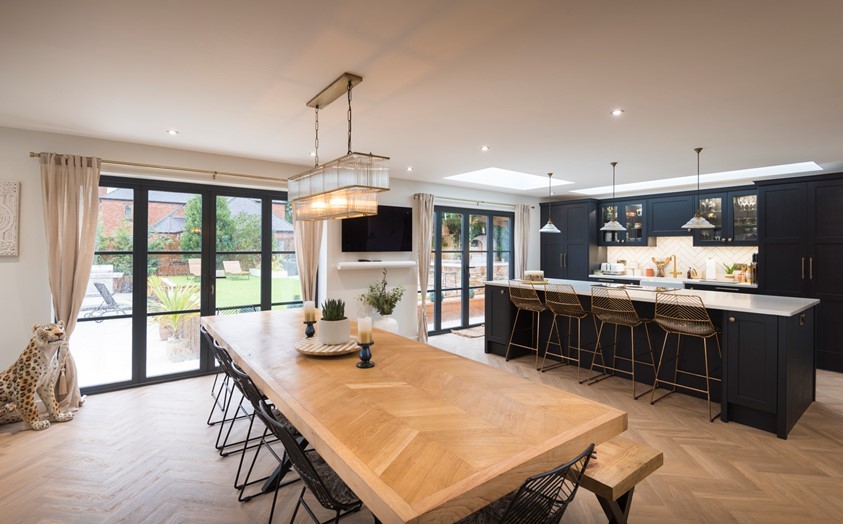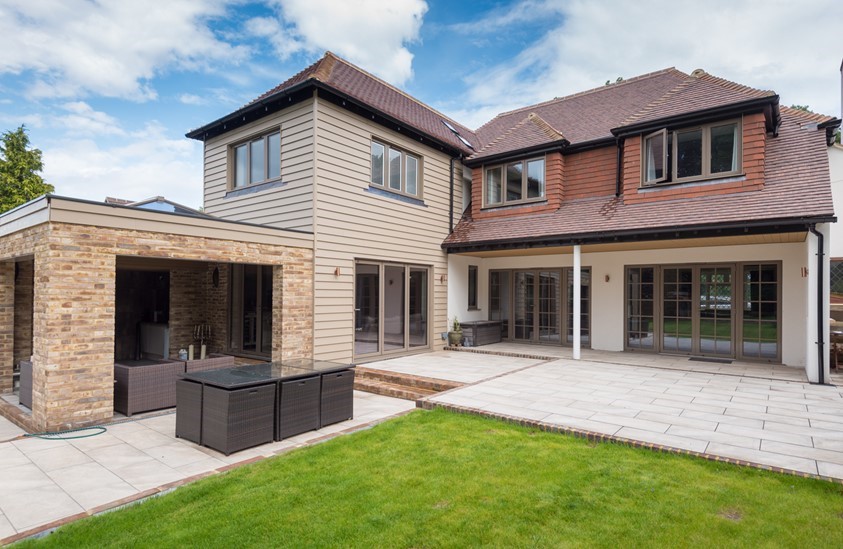Both double and triple-glazing increase the thermal and acoustic insulation levels of a home. Origin’s aluminium triple-glazed bifolding doors offer U-Values from only 0.78 W/m²K, surpassing the standard set by the British Building Regulations (As of June 2022).
So, how do you know which option of glazing is the right choice for your bifold, and what factors should you consider? Here, we discuss the key differences between double and triple glazing, and how to choose the right option for your bifold door.
In this guide:
Find out what options Origin can offer, and what factors you will need to consider when choosing glazing.
Read our guide to double vs triple glazing, including the key differences and benefits of each.
We provide a key summary of what points you need to consider before choosing your door.
Find out what other factors to consider before buying your ideal door.
Read the benefits of buying a bifold door from Origin.
Which glazing option is right for your bifold door?
At Origin, all bifold doors are bespoke, allowing you to find the perfect door design for your home. Origin Bifold Doors can accommodate double (24mm and 28mm) or triple-glazed (32mm) units. The Origin Window can also be manufactured with double (28mm) and triple (44mm) units. The doors or windows are manufactured according to the specified glazing size, and rest assured, the tolerance of each component is tested to make sure they can bear the extra weight. The right choice for your aluminium bifold door will ultimately be based on a number of factors – cost, time, and the energy efficiency targets you are wanting your home to achieve.
Are you choosing a new bifold door for your home? Read our full guide to choosing a high-quality bifold door design here.

Double-glazing vs triple-glazing – 4 points to think about before you choose
The clear advantage triple-glazing has over double is the increased insulation. The glazing is more efficient at keeping the heat in than double-glazing, so can make your home feel warmer. In the winter, it stops the heat from transferring into the outside environment, as well as preventing the cold air from entering the property. In the summer, it has the reverse effect, meaning that the warm air stays out, keeping it cool on the inside. This means that energy bills will be reduced, and your rooms will be usable all year round. A further advantage is that the extra layer of glass can reduce external noise pollution and improve acoustics, making it a beneficial choice for homes in urban areas.
These differences aside, we look at four important points to consider which will help you make the right choice for your home.
Are you looking for a Soho-style bifold door? Explore our Origin Soho External Door

Our all-new Soho Collection epitomises the pinnacle of luxury and style. With sightlines of just 36mm, the Soho External Door provides extensive glass panels for maximum natural light and an eye-catching aesthetic appeal for any property development. The sought after steel-look seamlessly merges cutting-edge design and ultra-slim sightlines with unparalleled functionality.
Contact your local installer today to bring your vison to life.
Find out more about how to choose a bifold door here.
Unlike any other door, our aluminium bifolds provide a completely uninterrupted view when open, and the flexibility to enjoy your indoor and outdoor space as one. Our doors are also available in 150 RAL colours, allowing you to find the perfect style for your home.
Shop our aluminium bifold door range.
To find out more about installing Origin Bifold Doors in your home and to find the right door type for your needs, please contact your local installer today.
A summary: key points to consider when choosing a glazing option
1) Sightlines
One of the main benefits of installing bi-folding doors is the superb views they allow and the amount of natural daylight they provide. The additional weight of triple-glazing means the maximum panel size available is smaller than when the doors are double-glazed, as larger triple-glazed doors would be too heavy to operate. The view is interrupted further as an additional door may be required due to the panel size being smaller, meaning that the door panels would be closer together, which in turn, increases the amount of aluminium profile getting in the way of the view. However, the sightlines of triple glazed aluminium are still impressive when compared to uPVC and timber frames and the benefits of triple-glazing go a long way towards negating these drawbacks.
As a comparison, Origin’s maximum door panel width for a standard height door (under 2.4m), is 1,200mm for double-glazed and 900mm for triple-glazed doors. Any doors above this height will have a bespoke width, given on a case-by-case basis.
Are you choosing the perfect bifold door for your home? Read our guide to choosing a bifold door design here.
2) Cost
Triple-glazed units can cost up to twice as much as a double-glazed alternative, so you will need to consider whether the value added to your home will outweigh the high initial cost of triple-glazed units. If you plan to stay in your home long term, then adding value to your property may not be a priority, so you can enjoy the benefits of triple-glazing without the concern of recovering the costs.
There’s no denying the acoustic and thermal benefits of triple-glazed bifold doors, but it’s worth weighing up the pros and cons so you can come to a decision whether double or triple-glazing is right for your home.
Are you choosing a new bifold door colour for your home? Read our full guide to choosing a bifold door colour here.
3) Climate and orientation of your home
Another key consideration when choosing between double and triple-glazing is the climate in your area and the orientation of your home. Homes located in colder regions of the UK, such as the Scottish Highlands or northern parts of England, may benefit more from triple-glazing due to the enhanced thermal insulation it provides. Conversely, for homes in milder southern regions, double-glazing may be sufficient and offer a better balance between performance and cost.
It’s also important to think about the direction your bifold doors will face. South-facing properties are more exposed to sunlight, meaning solar gain can naturally warm your home and reduce heating demands — in these cases, double-glazing may be ideal. North-facing or shaded spaces, however, can feel cooler and may benefit from the added insulation offered by triple-glazing to help maintain comfortable indoor temperatures.
By factoring in both the climate and the orientation of your bifold doors, you can make a more informed choice that aligns with your lifestyle, energy-saving goals, and budget.
 house image
house image
4) Security and glazing thickness
Glazing choice can also have a significant impact on the security of your bifold doors. While both double and triple-glazing options are built with safety and strength in mind, triple-glazing naturally adds an extra layer of protection due to the additional pane of glass and the increased thickness of the unit overall.
This enhanced thickness makes it more difficult for intruders to break through the glass, acting as a further deterrent against break-ins. For homeowners placing a strong emphasis on home security — especially in ground floor extensions, rear-facing gardens or more urban environments — the added robustness of triple glazing can offer additional peace of mind.
All Origin bifold doors, regardless of glazing choice, come with high-grade aluminium frames and are fitted with multi-point locking systems, internal beading, and toughened safety glass as standard. However, if maximum security is a top priority, upgrading to triple-glazing may be a worthwhile investment. Read how to choose a secure bifold door.
What else should you consider when buying a new bifold door?
You’ll have a number of decisions to make around the following:
Materials
Aluminium is known for its durability and strength, and you can find out more about the benefits of aluminium here.
Read more about choosing your bifold door material.
Configuration and design
How many door leaves do you choose, and in which direction are they going to open and fold? Read more about configurations, what they mean and how to choose. It is also important to consider your ideal aesthetic and design preferences. If you prefer a minimalistic style, you may want to go for a more simple, classic bifold door in colours such as black and white. Find out more about your bifold door design options here.
Threshold options
Should your door be weathered to guard against flooding, or non-weathered to be flush with the floor? Read more about choosing your threshold.
Get answers to your questions in our bi-fold door threshold FAQs.
Watch our YouTube video on flush non-weathered thresholds.
Accessories
Accessories play a key part in the appearance and security of your bifold door. Choosing a sturdy, secure handle material and style is vital, so it is important to put some thought into this and choose a high-quality supplier. It is also important to choose colours and styles of accessories that complement your bifold door. Find out more about bifold door accessories here.
Why choose Origin?
Quality and durable materials should be a top priority when adding value to the home. Here at Origin Global, we offer bespoke, high-quality external bifold doors that bring timeless style and much-valued natural light into your home. Moreover, our bifold doors offer U-Values from only 0.78 W/m²K. At Origin, we design as well as manufacture our own products, so that when a product from Origin has been specified, you can guarantee it has exclusively been crafted by us – from sourcing right through to delivery.
As Origin hold stock of the different glazing gaskets at Origin HQ, it means that triple glazed doors and windows can be delivered on the same lead times as double-glazed units, which can be as little as one working day on stock colour bi-fold doors and one week on windows. Read the benefits of choosing a thermally efficient bifold door here.




















